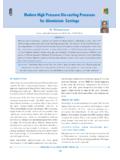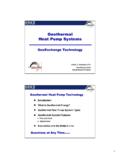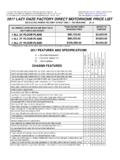Transcription of V200-18-E3XB Snap-in I/O Module - i4 Automation Ltd
1 V200-18-E3XB Snap-in I/O Module The V200-18-E3XB Features plugs directly into the 18 isolated digital inputs, includes 2 inputs, type pnp/npn back of compatible (source/sink). Unitronics OPLCs, creating a self- 15 isolated relay outputs contained PLC unit 2 isolated pnp/npn (source/sink) transistor outputs, includes 2 outputs with a local I/O. configuration. 4 isolated analog/PT100/TC inputs 4 isolated analog outputs Before using this product, it is the responsibility of the user to read and understand this document and any accompanying documentation. All examples and diagrams shown herein are intended to aid understanding, and do not guarantee operation. Unitronics accepts no responsibility for actual use of this product based on these examples.
2 Please dispose of this product in accordance with local and national standards and regulations. Only qualified service personnel should open this device or carry out repairs. User safety and equipment protection guidelines This document is intended to aid trained and competent personnel in the installation of this equipment as defined by the European directives for machinery, low voltage, and EMC. Only a technician or engineer trained in the local and national electrical standards should perform tasks associated with the device's electrical wiring. Symbols are used to highlight Symbol Meaning Description information relating to the user's The identified danger causes physical Danger personal safety and equipment and property damage.
3 Protection throughout this document. The identified danger can cause When these symbols appear, the Warning physical and property damage. associated information must be read carefully and understood fully. Caution Caution Use caution. Failure to comply with appropriate safety guidelines can result in severe personal injury or property damage. Always exercise proper caution when working with electrical equipment. Check the user program before running it. Do not attempt to use this device with parameters that exceed permissible levels. Install an external circuit breaker and take appropriate safety measures against short- circuiting in external wiring. To avoid damaging the system, do not connect / disconnect the device when the power is on.
4 Caution Ascertain that terminal blocks are properly secured in place. Environmental Considerations Do not install in areas with: excessive or conductive dust, corrosive or flammable gas, moisture or rain, excessive heat, regular impact shocks or excessive vibration. Provide proper ventilation by leaving at least 10mm of space between the top and bottom edges of the device and the enclosure walls. Do not place in water or let water leak onto the unit. Do not allow debris to fall inside the unit during installation. Unitronics 1. V200-18-E3XB Snap-in I/O Module 6/05. Wiring Do not touch live wires. Unused pins should not be connected. Ignoring this directive may damage the device. Do not connect the Neutral' or Line' signal of the 110/220 VAC to the device's 0V pin.
5 Double-check all wiring before turning on the power supply. Wiring Procedures 2 2. Use crimp terminals for wiring; use 26-12 AWG wire ( mm mm ) for all wiring purposes. 1. Strip the wire to a length of 7 ( inches). 2. Unscrew the terminal to its widest position before inserting a wire. 3. Insert the wire completely into the terminal to ensure that a proper connection can be made. 4. Tighten enough to keep the wire from pulling free. To avoid damaging the wire, do not exceed a maximum torque of N m (5 kgf cm). Do not use tin, solder, or any other substance on stripped wire that might cause the wire strand to break. Install at maximum distance from high -voltage cables and power equipment. I/O Wiring General Input or output cables should not be run through the same multi-core cable or share the same wire.
6 Allow for voltage drop and noise interference with input lines used over an extended distance. Use wire that is properly sized for the load. Digital Inputs Each group of 9 inputs has a common signal. Each group can be used as either pnp (source) or npn (sink), when appropriately wired as shown in the following figures. Inputs I0 and I2 can be used as normal digital inputs, as high - speed counters, or as part of a shaft encoder. Inputs I1 and I3 can be used as normal digital inputs, as high - speed counter resets, or as part of a shaft encoder. 2 Unitronics 6/05 V200-18-E3XB Snap-in I/O Module npn (sink) digital input wiring pnp (source) digital input wiring npn (sink) high - speed counter pnp (source) high - speed counter Inputs I0, I1, and I2, I3 can be used as shaft encoders as shown below.
7 Npn (sink) shaft encoder wiring pnp (source) shaft encoder wiring Unitronics 3. V200-18-E3XB Snap-in I/O Module 6/05. Digital Outputs Wiring Power Supplies Use a 24 VDC power supply for both relay and transistor outputs. 1. Connect the "positive" lead to the "V1". terminal, and the negative lead to the "0V". terminal. In the event of voltage fluctuations or non- conformity to voltage power supply specifications, connect the device to a regulated power supply Relay Outputs Each output can be wired separately to either AC or DC. as show below. The 0V signal of the relay outputs is isolated from the controller's 0V signal. Increasing Contact Life span To increase the life span of the relay output contacts and protect the device from potential damage by reverse EMF, connect: a clamping diode in parallel with each inductive DC load, an RC snubber circuit in parallel with each inductive AC.
8 Load. 4 Unitronics 6/05 V200-18-E3XB Snap-in I/O Module Transistor Outputs Each output can function as either npn or pnp, in accordance with jumper settings and wiring. Open the device and set the jumpers according to the instructions beginning on page 8. The 0V signal of the transistor outputs is isolated from the controller's 0V signal. npn (sink) pnp (source). Analog I/O Power Supplies Use a 24 VDC power supply for all analog input and output modes. 1. Connect the "positive" cable to the "V2" terminal, and the negative to the "0V" terminal. In the event of voltage fluctuations or non-conformity to voltage power supply specifications, connect the device to a regulated power supply. Since the analog I/O power supply is isolated, the controller's 24 VDC power supply may also be used to power the analog I/Os.
9 The 24 VDC power supply must be turned on and off simultaneously with the controller's power supply. Unitronics 5. V200-18-E3XB Snap-in I/O Module 6/05. Analog / PT100 / TC Inputs Each input may be set as either analog, RTD, or thermocouple. To set an input: - Use the appropriate wiring as shown below. - Open the device and set the jumpers according to the instructions beginning on page 8. Shields should be connected at the signal source. In order to function correctly, the analog power supplies must be wired as shown on page 5. To ensure proper performance, a warm-up period of a half an hour is recommended. Analog Inputs Inputs may be wired to work with either current or voltage. When set to current/voltage, all inputs share a common ACM signal.
10 Current current/voltage RTD Inputs 1. Wire one lead of each RTD input to the common signal (CM) as shown below. 4 wire PT100 can be used by leaving one of the sensor leads unconnected. PT100. 6 Unitronics 6/05 V200-18-E3XB Snap-in I/O Module Thermocouple Inputs Supported thermocouple types include B, E, J, K, N, R, S, and T, in accordance with software and jumper settings. See table Thermocouple Input Ranges, on page 15. Inputs may be set to mV by software settings (Hardware Configuration); note that in order to set mV inputs, thermocouple jumper settings are used. Thermocouple Analog Outputs Shields should be earthed, connected to the earth of the cabinet. An output can be wired to either current or voltage.





